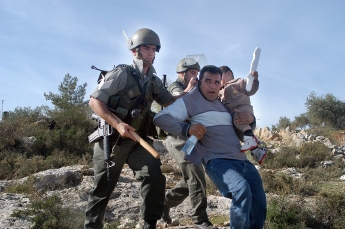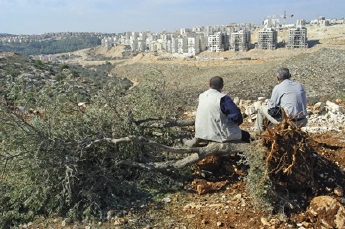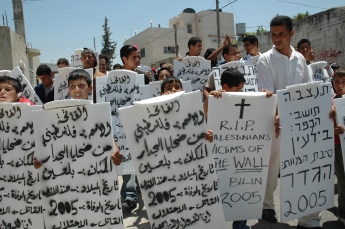|
Film Review
|
|
Bilin My Love: A True Story of Nonviolent Resistance
Shai Carmeli-Pollak’s documentary, “Bil’in Habibti” (Bilin My Love) pulls viewers into the heart of a nonviolent resistance campaign organized by Palestinian villagers with the support of Israelis and internationals. Pollak, a former Israeli Defense Forces (IDF) soldier, and his brother Yonatan lived in occupied Bil’in for over a year. Shai’s background enabled him to intimately document the effects of Israel’s wall and the villagers’ resistance through a lens few possess. The film, narrated in Hebrew with both Arabic and Hebrew dialogue (and English subtitles), lists Palestinian towns that have organized nonviolent protests against the wall: Biddu, Budrus, Beit Liqia, Zawiya, Mas’ha, Deir Balut, and Deir Qadis. When Shai began making the documentary, only Budrus villagers had prompted the Israeli Supreme Court to order the wall’s rerouting so as to confiscate less land. Bil’in’s efforts, however, attracted unprecedented international attention, and soon after the film’s release the residents managed to also convince the Israeli Supreme Court of their case (see sidebar). The film explores the protestors’ unwavering and peaceful strength that made success possible. Israel began constructing a wall/fence through the Palestinian West Bank in 2002. Israel claimed the barrier to be for security purposes; the wall also de facto expropriates vast tracts of Palestinian land, enabling Israel to both secure and enlarge its settlements. (All of Israel’s West Bank settlements are illegal under the Geneva Conventions.) The wall does not follow the 1949 Armistice Line (Green Line), instead slicing through Palestinian territory and splitting many villages like Bil’in. The large divergence led the UN’s International Court of Justice to declare the wall illegal, but the decision did not deter construction. Protestors who resist the wall call it an apartheid measure. The wall in Bil’in confiscates at least 50% (2000 dunams, 490 acres) of the village’s farmland. The structure itself takes up 260 dunams (about 65 acres) and then partitions 1,700 more dunams (420 acres) to expand Israeli settlements.1 The wall ostensibly serves to protect the Modi’in Illit settlement, but swings wide to encompass a new expansion called Matityahu East. Despite having no zoning approval, contractors began building Matityahu East on Bil’in land in 2004. Villagers found themselves separated from crops and livelihoods, and decided to act against injustice. Shai was there to record the resistance. Every Friday, Bil’in residents organized nonviolent demonstrations against the wall. At the beginning, Shai explains, dozens were injured every week. Word of Bil’in’s struggle spread, and groups of internationals and Israelis like “Anarchists Against the Wall,” “Rabbis for Human Rights,” “Gush Shalom,” “Yesh Din,” and “Coalition of Women for Peace” joined the Palestinians, hoping their presence would attract media attention and decrease violence. They performed innovative displays of strategic nonviolence. One day, for example, they sat inside a large cage to represent the effects of the wall. Often they marched beneath a large Palestinian flag chanting their resistance. Younger villagers sometimes threw stones at the IDF soldiers, drawing disapproval from some organizers, but other demonstrations involved no violence of any kind from the protestors. On the other hand, the IDF used tear gas, sound grenades, rubber-coated steel bullets (which can inflict lethal injuries), and occasionally even “regular” bullets. Undercover Israeli policemen would sometimes disappear into the crowd of demonstrators and throw stones, giving the IDF a pretext to react forcefully. For a more detailed account of the dynamic activism in Bil’in, see Israel/Palestine: No to Confiscation, Yes to Community. “Bil’in Habibti” introduces viewers to the villagers whose dynamism made such persistence possible. Wagee, a town patriarch, makes his appearance in the film inviting Pollak for tea in the midst of a chaotic Israeli raid. His son, Rani, paralyzed by nearly-lethal IDF fire during a 2000 protest, develops the idea for a “Disabled Persons March” in late 2005. Mohammed is a leader of the local Popular Committee Against the Wall, and walks at the front of every demonstration yelling witty chants in the face of IDF guns. They often appear superhuman in their persistence and courage, but sometimes their frustration emerges. In a rare quiet moment, Wagee mourns not only his stolen land, but all that went with it: olive trees over 200 years old, the fruits of years of nurturing, and his family’s connection to the area. Now those same olive trees are rapidly disappearing. At the time of filming, construction workers had uprooted 100,000 trees and replanted them so crowdedly that most quickly dried up. The Israeli government revoked Wagee’s permit to work in Israel because of his protesting, so the dwindling olive trees are his last source of income. If Israel completes the new Matityahu East settlement, Wagee laments that he, his family, and his friends will be refugees on their own soil. Yet such moments of despair and frustration do not wholly reflect the environment in Bil’in, which is usually positive and joyous. Wagee, Mohammed, and Rani possess resilient humor, creativity, and persistence characteristic of many villagers. Residents invite internationals into their homes to refuel with eggplant sandwiches before heading back to the chaotic and dangerous protests. The town celebrates together with large feasts and storytelling. Mohammed says in half seriousness, half jest that, “Before the Fence, everyone was busy with their own lives, so we didn’t get together much. Now you invite people, and they come over. That’s the good side of the fence, although it’s all shit.” Their attitude seems initially like nothing more than a necessary defense to protect against demoralization. As the film progresses, however, the protestors’ loving strength becomes recognizable as an instigator for effective conflict transformation. The local IDF battalion commander’s fleeting acknowledgement of the situation’s injustice reveals a glimpse of the villagers’ power. Usually quiet and unresponsive, Lieutenant Colonel Tzachi tells a journalist that he “feels these peoples’ pain” at the end of the film. When Shai reads Tzachi’s statement and expresses his surprise, the commander responds, “Why are you surprised? You think you’re the only one with human emotions?” Twenty minutes later, Tzachi warns the protestors they are once again trespassing on government property, and unless they show him a protest permit, he will open fire. In a few moments, IDF soldiers are throwing tear gas grenades, firing rubber-coated steel bullets, and running after and arresting protesters. A restrained Israeli activist yells to his captors, “What’s with you? What have they done to you? Why do you obey such orders?” The events reveal the situation’s complexity, and provide a window into the thought processes and emotions of those instructed to perpetrate unjust and inhumane acts. The documentary allows people across the world to see the gritty reality of the Israeli/Palestinian conflict, unfiltered by third parties with hidden agendas. Pollak’s agenda, for one, is clear: to reveal the injustice of the wall. He does his job so well viewers may become hopeless about prospects for peace. The decades of occupation have driven a wedge between occupier and occupied to the point of hiding from one group the shared humanity of the other. The soldiers, for example, order only the Palestinians, not the Israelis or internationals, to disperse from the site of the protest. Tzachi addresses by name only Yonatan and Shai—the most prominent Israeli resistors—and attributes the resistance movement to them, despite their bystander status and Mohammed’s clear leadership. Mohammed later tells Shai, “Maybe you, as an Israeli, know what occupation is because you are one of the occupiers. That’s how I define you, Shai.” Despite having spent months in the same small village, eating and protesting together, a barrier still remains. It grows when occupation defines life, when things are most easily described in terms of that injustice. It is why six fully armed IDF soldiers chase one unarmed Palestinian demonstrator into a ravine to arrest him for protesting. It is why they arrive at 3 a.m. to arrest two pre-teens for throwing stones earlier in the day, sending them to jail for an estimated three to six months. That barrier is the reason for utter irrationality, for the dehumanization of the other side. Yet it is not permanent. The commander’s moral crisis, however short-lived, reveals an attempt to embrace the humanity of each participant. Rani, the Palestinian organizer of the march of the disabled and one of Shai’s good friends, earns the film’s final subtitles when he tells Shai that if “I love you” means more than “I like you,” then he without a doubt loves Shai. “Bil’in Habibti” shows the power of each participant to alter the course of the wall with nonviolent resistance and an open mind. It inspires hope that people across the globe may learn from the successful protestors and transform injustice everywhere. Israeli Supreme Court Rules for Partial Justice in Bil’in – But Military Refuses to Implement the OrderOn September 4, 2007, the Israeli Supreme Court ruled the path of the wall dividing Bil’in illegal, and ordered the military to reroute it 1.7 km west, returning 250 acres (1,011 dynams) of land to Bil’in.2 Although the court’s decision is an important step forward for justice and peace in Palestine, activists are quick to note that words alone are not enough. The Israeli military has a history of ignoring Supreme Court orders, and as of this writing, the wall still stands in Bil’in.3 Moreover, five days after its ruling, the Court retroactively approved the completed section of the Matityahu East settlement (the western half). It stated that the wall’s new route must protect the structures there, meaning that the nearly 1,000 dunams of Bil’in land on which they are built will not be returned.4 Activists continue to gather beside the wall on Fridays, protesting the Court-validated, illegal settlement and attempting to effect the return of all of their stolen land.5 |
|
|
Resources: References: |



